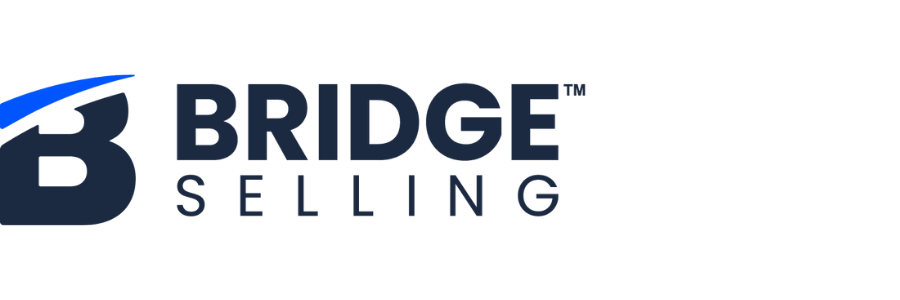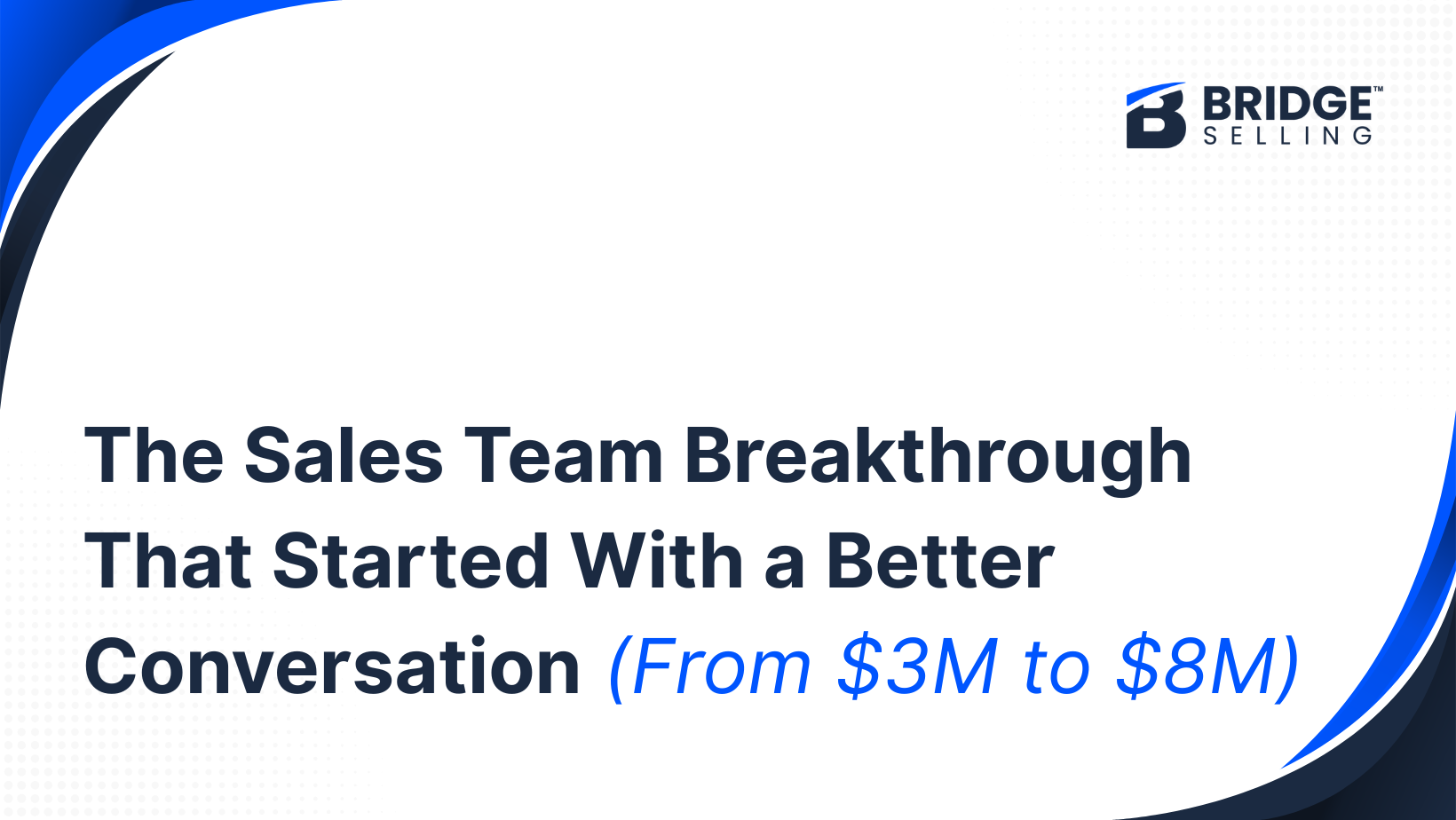How we helped an 8-person sales team grow from $3 million to $8 million in a single month, without increasing leads, hiring a new team, changing their product, or launching a big campaign.
What changed?
They stopped winging their sales calls.
Before developing the BridgeSelling™ System, I spent years helping companies clarify their marketing messaging using the StoryBrand framework. I saw firsthand how powerful a well-told story could be in marketing.
But what I kept seeing was this:
Even with clear messaging, sales conversations still fell apart.
The issue wasn’t the offer. It wasn’t the team. It was the conversation structure — or more accurately, the lack of one. I saw this challenge again and again.
But the idea for what would become the BridgeSelling™ Framework didn’t hit until I was 36,000 feet in the air, flying home from hearing Donald Miller speak about the importance of customer-centric communication. He said,
"We need to build a bridge from our customer's problem to our solution."
That one line stuck.

Somewhere over middle America, I started sketching a call flow on a notepad that would help reps connect the dots:
- From the customer’s pain to the proposed solution
- From uncertainty to clarity
- From a wandering conversation to a confident close
That sketch became the foundation for what would eventually evolve into the BridgeSelling™ System.
Not long after, I had the opportunity to work with a sales team that was closing around $3M/month.
The offer was strong. The leads were flowing. But they were well behind targets and trending towards a very dark reality if sales didn’t rise fast.
The biggest issue was that every sales conversion was all over the place.
Each rep had their own style. Some were smooth talkers, some were thorough. Some just talked too much. No one was following the same structure.
And no one could explain why one call led to a close and another didn’t.
So I did what most sales trainers don’t: I listened to an obsessive amount of their calls.
Dozens of them. Then hundreds.
And what I found wasn’t a single structure that the top reps were following, because there wasn’t one.
But in the calls that consistently closed, I noticed something else:
There were common moves — moments in the conversation where the rep asked the right question, clarified the real problem, or guided the buyer forward with confidence.
These weren’t scripted. They weren’t even in the same order. But they were consistently effective.
That was the insight we needed:
The best calls weren’t smooth because they followed a structure.
They were effective in spite of not having one.
It was time to test and refine the Bridge framework I had sketched months earlier.
So we got to work — shaping it into a guide every rep could use in their first sales conversation, not just the naturals.

It became the foundation for what eventually evolved into the BridgeSelling™ System.
In this article, I’ll show you:
- The problem most sales teams don’t realize they have
- The common “fixes” that don’t actually fix anything
- The six-move structure that changed everything for this team
- And how we turned that framework into a complete system for coaching, scoring, and scaling.
Let’s break it down.
The Real Problem Most Sales Teams Face
Most sales leaders can tell you which reps are closing and which ones aren’t. What they can’t always tell you is why.
When I started reviewing this client’s call recordings, what stood out wasn’t something flashy, it was the absence of structure. There was no shared approach, no common language, no consistent flow.
Every rep ran the conversation differently. Some jumped straight into product features. Others circled the problem a customer faced but never named it. A few just talked and hoped something would stick. Many talked endlessly about random things to build rapport, only to have the call end without advancing the sale.
And because there was no standard, there was no way to coach effectively, no way to measure progress, and no way to replicate success.
That’s the real problem most sales teams face. Not lack of effort. Not lack of leads. Just a lack of structure at the conversation level — where deals are actually won or lost.
And when you don’t have a consistent approach:
- You can’t coach reps effectively
- You can’t identify what’s working and scale it
- You can’t improve results because you’re not measuring the right thing
This team wasn’t underperforming because they didn’t care or weren’t skilled. They were underperforming because they didn’t have a defined sales call structure that worked, one they could use, adapt, and improve with.
And that’s where many sales trainings fall short.
They go deep on one piece of the conversation — uncovering the pain, handling objections, closing strong — but they don’t give reps a repeatable call flow from start to finish. The result? Teams end up with disconnected tactics instead of a cohesive framework they can follow and coach to.
The good news? Once they had that structure, performance took off.
But before we get to the solution, let’s talk about what doesn’t work — even though most companies try it first.
The False Fixes (Myths Sales Teams Believe)
When sales performance is lagging, most companies reach for the same fixes and most of them miss the mark.

Here’s what they typically try:
“We need more leads.”
- If your reps can’t consistently convert the leads you already have, adding more is like pouring water into a leaky bucket.
“Let’s hire another closer.”
- Another person can’t fix a broken process. If you don’t know why your current team is inconsistent, adding a new rep just adds more guesswork.
“We need better scripts.”
- Scripts can help with consistency — but only if they’re used as a guide, not a crutch. Without a solid call structure underneath, even the best script sounds flat or forced.
“We should invest in more sales tech.”
- Technology can support a great system. It can’t create one. CRM tools and automations don’t fix unstructured conversations.
“Let’s bring in a trainer or give reps a book to motivate the team.”
- Motivation is a sugar rush. What reps actually need is a way to win more often. Confidence comes from clarity and control — not hype.
And here’s one more that’s easy to miss:
“We’ve already done sales training.”
- Most training programs go deep in one area — discovery, objection handling, personality types, or closing techniques. That’s valuable. But without a complete call flow to anchor those skills, reps are left stitching together tactics on their own. The result is inconsistency and guesswork.
→ That’s where BridgeSelling™ comes in.
We don’t compete with proven methodologies. We complete them.
Our system gives teams a flexible, repeatable call flow that supports whatever sales approach they already believe in. It gives their training something to live inside of.
Once this client had the structure that worked from the first hello to the final close, everything changed.
The Shift – Build a Bridge
Once we confirmed the problem wasn’t the team, the offer, or the volume of leads — it was the lack of a repeatable call structure — we started testing and refining our call flow framework.
I took my earlier sketch and what I had heard in the best-performing calls and started mapping out the moves that made those conversations work. Not lines to memorize. Just clear, repeatable steps that guided the conversation from first question to confident close.
We turned those patterns into a call framework that fit their team:
- Their language
- Their product
- Their sales process
We gave each step a clear purpose and defined what “great” looked like at each stage — not generically, but for their business.
What started as a theory was refined from listening to real calls and building a structure the team could actually use.
.png)
And once they started using it?
Revenue climbed from $3 million to $8 million in a single month. It didn’t stop there, in less than a year, they were at $33M a month, with only three additional reps added to their team.
That original framework later grew into what’s now the BridgeSelling™ System. But its impact came from something simple: giving every rep a reliable way to lead a call from start to finish.
The Six Steps of the BridgeSelling™ Framework
What we proved effective with this team, and now use with every client, is a flexible six-step structure for running effective sales calls. And any company can use it.
We call it The Bridge.
These aren’t magic phrases or rigid scripts. They’re the core moves that top-performing reps make consistently — the ones that move the conversation forward, qualify the opportunity, and help the buyer make a clear decision.
Here’s the high-level flow:
- Pinpoint the Pain
Don’t guess. Don’t assume. Start the call by surfacing the real problem the buyer wants solved — the one that’s driving urgency and why they called today. - Qualify the Lead
You’re not here to sell everyone. You’re here to figure out whether this buyer is a good fit for your offer — and whether your offer is a good fit for their situation. - Solution + Success
Connect your product or service directly to the pain they shared. Show them what success looks like, not just what your product does. - Q&A
Invite tough questions. Don’t dodge them. This is where trust is either earned or lost. - Three Next Steps
Give the buyer a clear path forward, even if the sale doesn’t close on this call. Eliminate confusion and keep momentum. - Close or Schedule
Don’t end the call with “Thanks for your time” or “Reach out with any questions.” End with a decision — either a close, or a specific next call on the calendar.
That’s The Bridge in its simplest form, and it’s the same structure we started with on that $3M-to-$33M journey.
But here’s the key: Every company’s version is different.
When we work with a client, we help them customize the Bridge to fit their internal language, product flow, and buyer behavior.
Sometimes the order shifts. Sometimes the names change. We also define what “scoring 100%” looks like at each step based on their actual sales process.
That’s what makes the BridgeSelling™ Framework so effective:
It’s consistent enough to scale.
It’s flexible enough to feel native to your team.

Proof – What Happened Next
Once this team started using their custom Bridge, the shift was immediate.
Calls felt more focused. Reps knew what to say and when. And buyers? They stopped ghosting and started closing.
In less than a year:
- Monthly revenue jumped from $3 million to $33 million
- Team size only grew from 8 to 11 reps
- No change in pricing, product, or market
- The only real change? A structured call flow that everyone followed
But it wasn’t just about the structure It was about how they used it.
We introduced a simple, consistent way to measure call quality using a tool we call BridgeScore™. Every call was scored across the six steps of the Bridge, with clear definitions for what “great” looked like at each point in the conversation.
And the data told the story:
Calls that scored 14 out of 20 or higher had a significantly higher close rate.
The team now had a shared language for what good looked like. Sales leaders could coach more effectively. Reps could self-assess and adjust. And performance started to compound.
No more guesswork. No more winging it. Just confident, consistent calls with results that match.
From Framework to Full System
The Bridge framework is the heartbeat of a great sales call but to drive consistent, lasting improvement across a team, you need more than just a flow. You need a system that makes it coachable, measurable, and adaptable.
That’s where the full BridgeSelling™ System comes in. Here’s how it works:
Magic Pivots
These are the simple, flexible transitions that help reps move smoothly from one step of the Bridge to the next.
No awkward shifts. No robotic segues. Just natural language that keeps the conversation moving.
BridgeFit
This is where we define what makes a lead sales-qualified — not in theory, but for your company.
BridgeFit gives reps a clear filter to use mid-call so they know whether to move forward or walk away.
BridgeScore
This is how we measure performance — not just on outcomes, but on execution.
We customize scoring for each client, defining what a 100% looks like in every step of the Bridge. That way, coaching isn’t opinion-based. It’s anchored in clear, agreed-on standards.
These tools work together to help your team:
- Run better calls
- Qualify more effectively
- Improve faster
- And close with confidence
It’s not just a framework. It’s a repeatable sales system that grows with your team.
What You Can Do Now
If your sales calls feel inconsistent…
If your reps are saying the right things but deals keep stalling…
If coaching feels like chasing symptoms instead of solving root problems…
You don’t need a new CRM.
You don’t need more reps.
You don’t need to start from scratch.
You need a structure that helps your team qualify better, guide the buyer, and close with confidence.
Here’s where to start:
Get Your Call Clarity Score
How structured are your team’s sales conversations? Take 5 minutes to find out with our free self-assessment.
.png)
Book a Call with Us
If you’re ready to build a custom BridgeSelling™ System for your team, let’s talk about what that would look like.
You’ve already got a good team. Let’s give them a better framework.
Closing Thought
Most sales teams don’t fail because they lack talent.
They fail because they lack structure.
When every rep is running their own play, even strong leads get lost in the chaos. But when you give your team a clear framework — one they can follow, coach to, and improve over time — the game changes.
You don’t need to push harder. You need to call smarter.
That’s what the BridgeSelling™ System delivers:
- Clarity for your reps.
- Confidence for your buyers.
- And a process that works — again and again.



